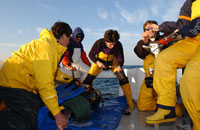
 Barb Block from the Shogun Expedition. We spent a few days hunting bluefin and scored some nice albacore fishing and a fantastic view of a blue whale mom and calf. We continue to have challenges getting bluefin to bite our live sardines. One reason may be because the bluefin are feeding on anchovy bait balls -- schools of anchovies driven to cluster by larger fish attacking them -- and getting them to switch to sardines is a challenge. A second reason may be that the fish were boat shy from the commercial fishing efforts in the region.
Barb Block from the Shogun Expedition. We spent a few days hunting bluefin and scored some nice albacore fishing and a fantastic view of a blue whale mom and calf. We continue to have challenges getting bluefin to bite our live sardines. One reason may be because the bluefin are feeding on anchovy bait balls -- schools of anchovies driven to cluster by larger fish attacking them -- and getting them to switch to sardines is a challenge. A second reason may be that the fish were boat shy from the commercial fishing efforts in the region.We decided to change our tactics. We headed to Ensenada, Mexico, to work with the ranchers at Maricultura del Norte, a spectacular bluefin ranch that catches wild bluefin and holds them in pens. We went down to the pens where in previous years the ranch helped our scientists release small bluefin tuna for our archival tagging study .
The ranch owners allowed us to approach a pen and “fish” from the stock. While it sounds easy to execute this “fish in the barrel” effort, it takes careful planning to catch a live bluefin and safely transfer the fish from the pens to the wells flowing with seawater on the Shogun. Captain Bruce and Sean were the fishers; they used a line and circle hook. They caught the fish and transferred each fish to a seawter sling. Luis Rodriguez and Ty Brandt from the Tuna Research and Conservation Center removed the hook and passed the fish to researchers Andy Seitz and Kurt Schaefer who motored in a Zodiac over to the Shogun swim step, where Dan and Jake lifted the fish to the deck of the shogun. We measured each fish and placed it in the “slammer” -- the back bait well on the Shogun. It was quite the operation.
We sampled several fish by placing small tissues in liquid nitrogen -- a quick way of super-cooling muscle samples -- for a new national NOAA-funded aquaculture project we have started in collaboration with the fish ranchers. We hope to develop several genomic markers for conditioning that will help establish the health and aerobic status of bluefin in captivity. All and all, it was a fun day with innovative techniques made possible by the ever versatile crew aboard the F/V Shogun. ABOARD THE F/V SHOGUN, off Ensenada, Mexico.








